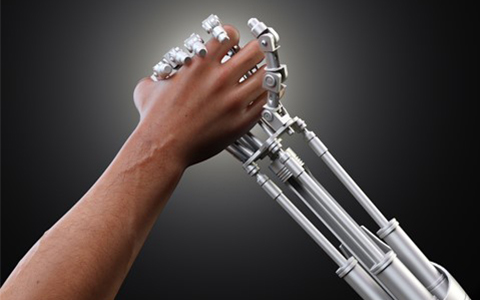Background
Project: SMARTHAND
As far as medical research has come towards treating illness and injury, doctors and technicians have yet to develop an artificial hand that can give amputees the sensation of having a natural hand. This could be on the verge of changing. A team of EU-funded researchers has invented a prosthetic hand that has all the basic features of a real hand, and that amputees can actually feel.

The SmartHand project succeeded in developing a system that essentially tricks the brain into thinking that a real hand is attached to a person’s arm.
“What for decades has been one of medicine’s greatest challenges, we are now one step closer to solving,” says SmartHand coordinator Fredrik Sebelius of Lund University in Sweden. “This offers hope to amputees for a more functional artificial hand,” he adds.
Sebelius led a team that combined neuroscience, biotechnology and information technologies to develop an artificial hand that patients were able to experience, to some degree, as their own.
Key to the breakthrough is the phenomenon by which amputees imagine that their missing hand is still there – to the point that they feel what is known as “phantom sensation.” Even if a person’s hand is missing, the “hand area” is still present in the brain. This means an amputee can still imagine that the missing hand is moving.
“The artificial hand we developed can actually be controlled by an amputee’s thoughts,” says Sebelius. “If a person thinks about opening or closing their hand, these signals are sent to the prosthetic hand – and the fingers move accordingly.”
In another intriguing effect, touching a certain part of an amputee’s arm can be perceived as touching the missing hand. The SmartHand team developed a system that can stimulate this “phantom map,” with the result of causing sensation in the missing hand.
The brain’s connection to the missing hand is so strong that it can be tricked into believing that the prosthetic hand is real. Amputees who tested the SmartHand “felt” that the hand was being touched and experienced the illusion that it was their own. They even began to sweat when the artificial hand’s rubber skin was poked with a needle.
The SmartHand device is equipped with a number of small motors that allows each finger to move separately, as well as sensors that control how hard the hand grips an object.
“We have designed and produced an artificial hand that gives a person a realistic sensation of having a natural hand,” says Sebelius.
Even beyond the physical disability that amputees suffer, many must also deal with depression, a distorted self-image, and the fear of social rejection. Moreover, phantom pains, which do not ease over time, often require people to take pain medication.
Up until recently, artificial hands provided only limited benefits. They could only move in simple ways, had no sensory abilities, needed heavy batteries, and were difficult to keep clean. As a result, many amputees chose not to use them. “What we have developed could truly help people overcome these difficulties,” concludes Sebelius.
This innovation was made possible by Israel’s continued participation in the official Horizon 2020 fund, managed in Israel by ISERD part of The Israel Innovation Authority (Formerly the Office of the Chief Scientist and MATIMOP). The initiative has taken Israeli R&D to the next level with the help of ground-breaking collaboration between scientists in Israel and Europe, as well as essential funding and support.
Project details
Project acronym: SMARTHAND
Participants: Sweden (Coordinator), Denmark, Iceland, Italy, Israel, Irealand
Proj. N° 33423
Total costs: € 1 980 000
EU contribution: € 1 800 000
Duration: November 2006 – January 2010
